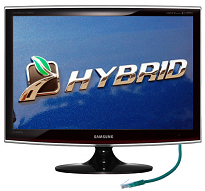The final day of NAB 2009 was relatively quiet. The total official attendance over the whole 5 days was 80,000 vistors - not bad, but 20-30% down on a 'normal' year that is not beset by our current financial woes and uncertainties.
"Alternative Fuel" for your TV
This last day of NAB 2009 may also have been historic as it saw the birth of interest in the technology of combining television and broadband Internet - Hybrid Broadcast Broadband or HBB. The NBC television network and NAB organised a meeting of broadcasters, to dicuss the potential of the system.
 | The viewer uses the TV handset to call up the web browser now included in the receiver. This pulls down web content from a selected web site, and provides it as an overlay on top of whatever TV channel that is currently being viewed. The overlay may or may not be associated to the TV programme. The overlay can contain anything that a web page can provide as content - news, weather, sports information, stock prices, YouTube clips, photos, and even full-length on-demand TV programmes displayed in full screen. |
How will this affect broadcasters? Who will be in control of the overlays? These were some of the questions on the floor. The group will meet again to take the discussion a stage further in September 2009.
Overall, what were the highlights of NAB 2009? The majority of American broadcasters would surely say it was the growth of interest in broadcasting to handhelds using the new ATSC H/M technology, and the planning of trial services at the end of the year. The emerging evidence of 1080p 50/60Hz as a high quality production standard would also be another important element. Most certainly, no-one could fail to miss the assault of 3-D TV across the show. The show brought repeated exposure to TV pictures with four thousand lines (4K), and one becomes more and more convinced that this will really be used both for programme production and d-cinema in future. Once atuned to sparkling 4K quality (which you see however close to the screen you are) you want it!
